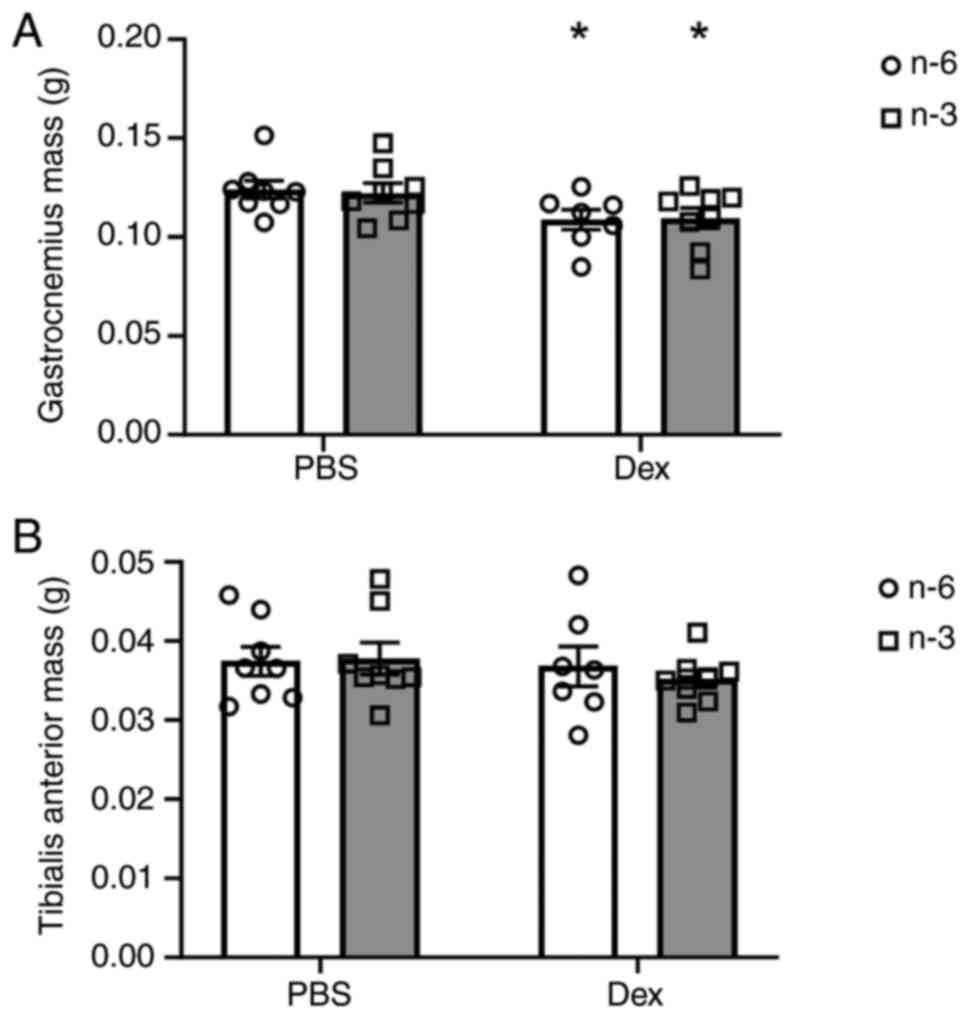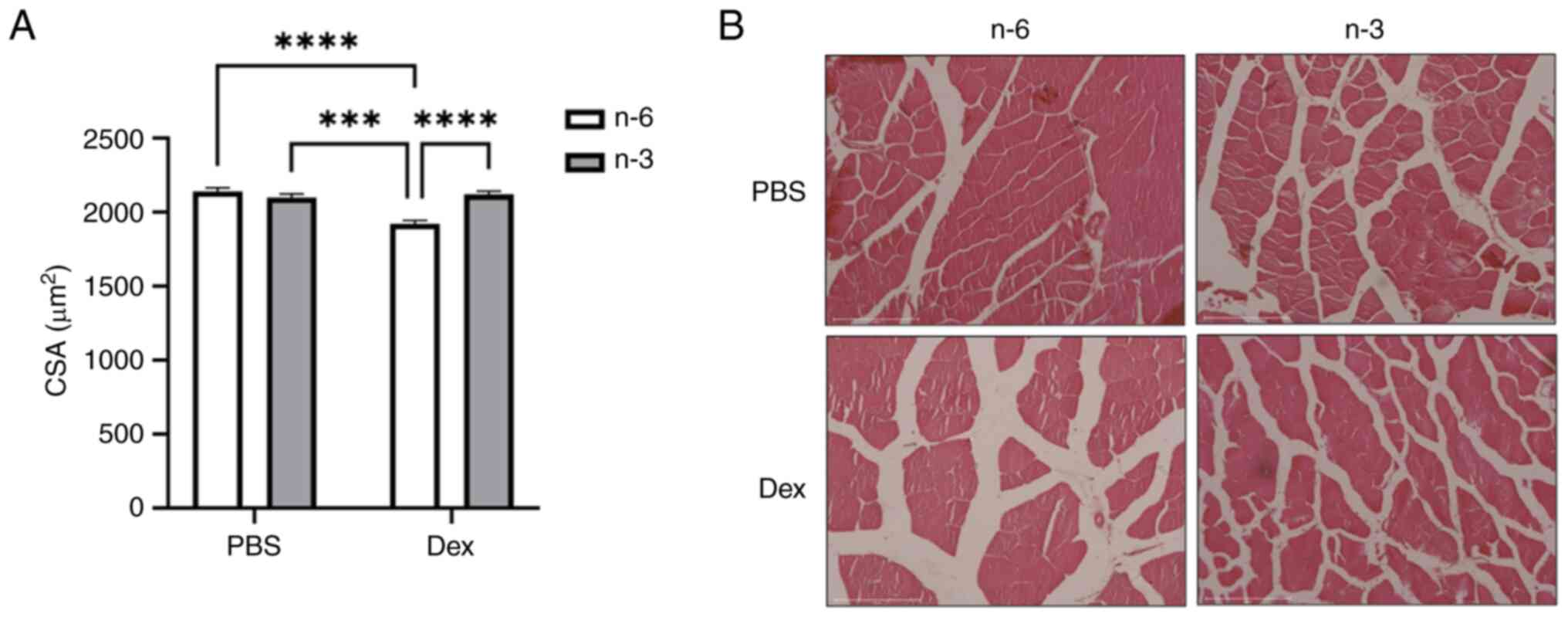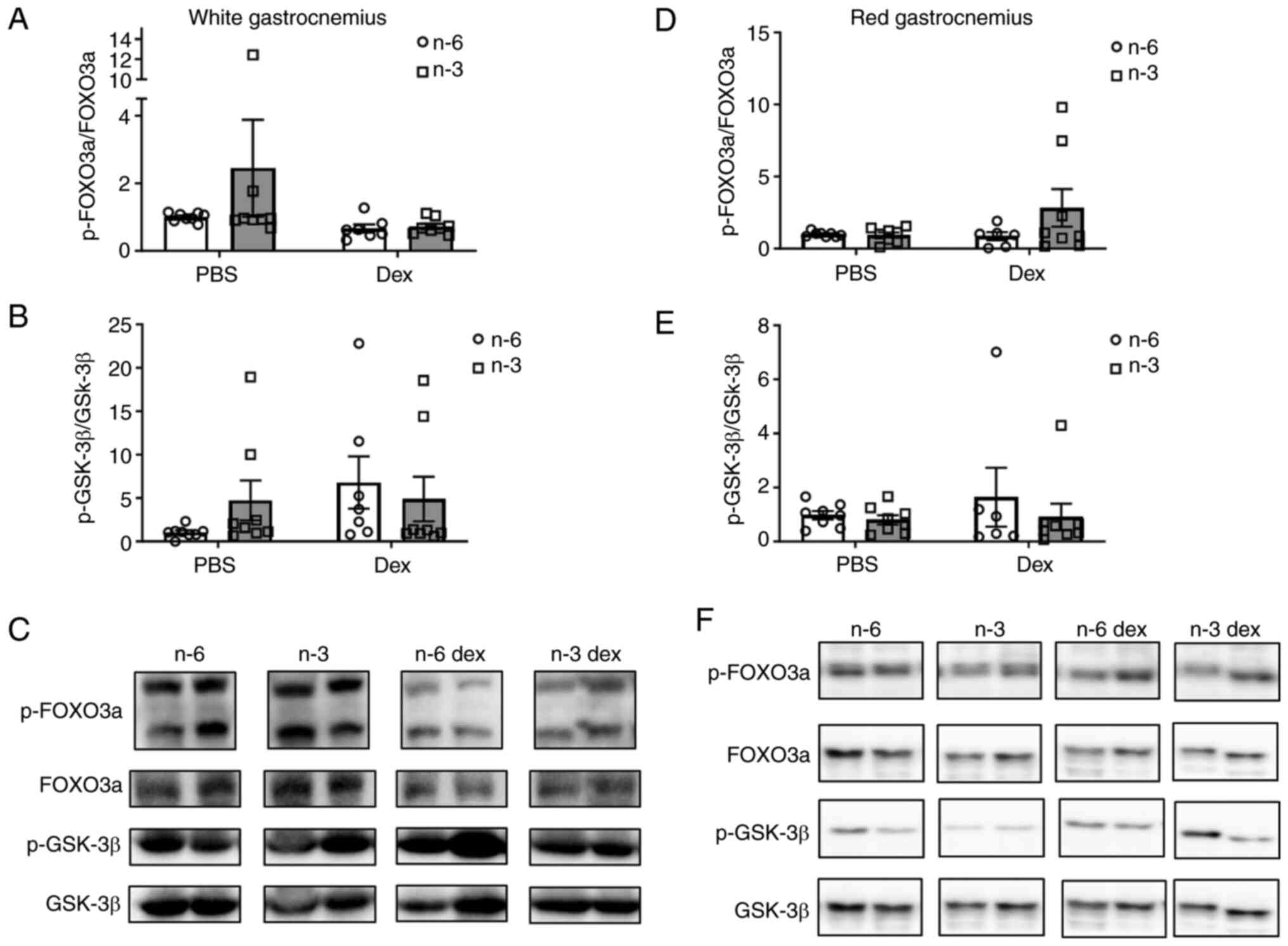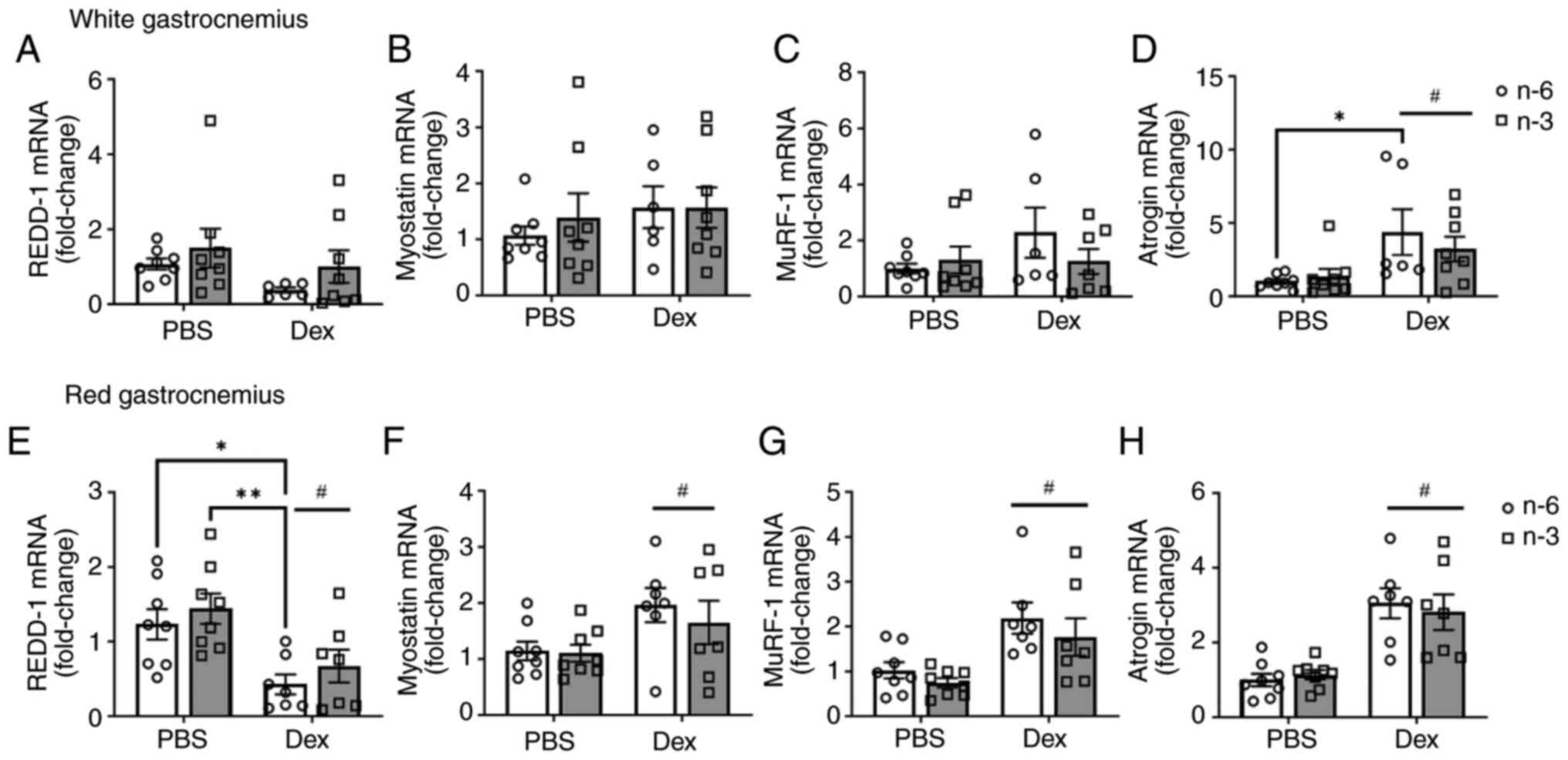|
1
|
Wolfe RR: The underappreciated role of
muscle in health and disease. Am J Clin Nutr. 84:475–482.
2006.PubMed/NCBI View Article : Google Scholar
|
|
2
|
Sandri M: Protein breakdown in muscle
wasting: Role of autophagy-lysosome and ubiquitin-proteasome. Int J
Biochem Cell Biol. 45:2121–2129. 2013.PubMed/NCBI View Article : Google Scholar
|
|
3
|
Jeromson S, Gallagher IJ, Galloway SD and
Hamilton DL: Omega-3 fatty acids and skeletal muscle health. Mar
Drugs. 13:6977–7004. 2015.PubMed/NCBI View Article : Google Scholar
|
|
4
|
Fappi A, Godoy TS, Maximino JR, Rizzato
VR, Neves Jde C, Chadi G and Zanoteli E: The effects of omega-3
fatty acid supplementation on dexamethasone-induced muscle atrophy.
Biomed Res Int. 2014(961438)2014.PubMed/NCBI View Article : Google Scholar
|
|
5
|
Schakman O, Kalista S, Barbe C, Loumaye A
and Thissen JP: Glucocorticoid-induced skeletal muscle atrophy. Int
J Biochem Cell Biol. 45:2163–2172. 2013.PubMed/NCBI View Article : Google Scholar
|
|
6
|
Bodine SC, Latres E, Baumhueter S, Lai VK,
Nunez L, Clarke BA, Poueymirou WT, Panaro FJ, Na E, Dharmarajan K,
et al: Identification of ubiquitin ligases required for skeletal
muscle atrophy. Science. 294:1704–1708. 2001.PubMed/NCBI View Article : Google Scholar
|
|
7
|
Braun TP and Marks DL: The regulation of
muscle mass by endogenous glucocorticoids. Front Physiol.
6(12)2015.PubMed/NCBI View Article : Google Scholar
|
|
8
|
McGlory C, Calder PC and Nunes EA: The
influence of omega-3 fatty acids on skeletal muscle protein
turnover in health, disuse, and disease. Front Nutr.
6(144)2019.PubMed/NCBI View Article : Google Scholar
|
|
9
|
Auvinen HE, Coomans CP, Boon MR, Romijn
JA, Biermasz NR, Meijer OC, Havekes LM, Smit JW, Rensen PC and
Pereira AM: Glucocorticoid excess induces long-lasting changes in
body composition in male C57Bl/6J mice only with high-fat diet.
Physiol Rep. 1(e00103)2013.PubMed/NCBI View
Article : Google Scholar
|
|
10
|
Gingras AA, White PJ, Chouinard PY, Julien
P, Davis TA, Dombrowski L, Couture Y, Dubreuil P, Myre A, Bergeron
K, et al: Long-chain omega-3 fatty acids regulate bovine whole-body
protein metabolism by promoting muscle insulin signalling to the
Akt-mTOR-S6K1 pathway and insulin sensitivity. J Physiol. 579 (Pt
1):269–284. 2007.PubMed/NCBI View Article : Google Scholar
|
|
11
|
Kamolrat T and Gray SR: The effect of
eicosapentaenoic and docosahexaenoic acid on protein synthesis and
breakdown in murine C2C12 myotubes. Biochem Biophys Res Commun.
432:593–598. 2013.PubMed/NCBI View Article : Google Scholar
|
|
12
|
Khal J and Tisdale MJ: Downregulation of
muscle protein degradation in sepsis by eicosapentaenoic acid
(EPA). Biochem Biophys Res Commun. 375:238–240. 2008.PubMed/NCBI View Article : Google Scholar
|
|
13
|
Liu Y, Chen F, Odle J, Lin X, Zhu H, Shi
H, Hou Y and Yin J: Fish oil increases muscle protein mass and
modulates Akt/FOXO, TLR4, and NOD signaling in weanling piglets
after lipopolysaccharide challenge. J Nutr. 143:1331–1339.
2013.PubMed/NCBI View Article : Google Scholar
|
|
14
|
Murphy RA, Mourtzakis M, Chu QS, Baracos
VE, Reiman T and Mazurak VC: Nutritional intervention with fish oil
provides a benefit over standard of care for weight and skeletal
muscle mass in patients with nonsmall cell lung cancer receiving
chemotherapy. Cancer. 117:1775–1782. 2011.PubMed/NCBI View Article : Google Scholar
|
|
15
|
Ryan AM, Reynolds JV, Healy L, Byrne M,
Moore J, Brannelly N, McHugh A, McCormack D and Flood P: Enteral
nutrition enriched with eicosapentaenoic acid (EPA) preserves lean
body mass following esophageal cancer surgery: Results of a
double-blinded randomized controlled trial. Ann Surg. 249:355–363.
2009.PubMed/NCBI View Article : Google Scholar
|
|
16
|
Smith GI, Atherton P, Reeds DN, Mohammed
BS, Rankin D, Rennie MJ and Mittendorfer B: Dietary omega-3 fatty
acid supplementation increases the rate of muscle protein synthesis
in older adults: A randomized controlled trial. Am J Clin Nutr.
93:402–412. 2011.PubMed/NCBI View Article : Google Scholar
|
|
17
|
Smith GI, Julliand S, Reeds DN, Sinacore
DR, Klein S and Mittendorfer B: Fish oil-derived n-3 PUFA therapy
increases muscle mass and function in healthy older adults. Am J
Clin Nutr. 102:115–122. 2015.PubMed/NCBI View Article : Google Scholar
|
|
18
|
You JS, Park MN, Song W and Lee YS:
Dietary fish oil alleviates soleus atrophy during immobilization in
association with Akt signaling to p70s6k and E3 ubiquitin ligases
in rats. Appl Physiol Nutr Metab. 35:310–318. 2010.PubMed/NCBI View
Article : Google Scholar
|
|
19
|
Castillero E, Martin AI, Lopez-Menduina M,
Villanua MA and Lopez-Calderon A: Eicosapentaenoic acid attenuates
arthritis-induced muscle wasting acting on atrogin-1 and on
myogenic regulatory factors. Am J Physiol Regul Integr Comp
Physiol. 297:R1322–R1331. 2009.PubMed/NCBI View Article : Google Scholar
|
|
20
|
Lee JM, Lee H, Kang S and Park WJ: Fatty
Acid desaturases, polyunsaturated fatty acid regulation, and
biotechnological advances. Nutrients. 8(23)2016.PubMed/NCBI View Article : Google Scholar
|
|
21
|
Murphy RA, Mourtzakis M and Mazurak VC:
n-3 polyunsaturated fatty acids: The potential role for
supplementation in cancer. Curr Opin Clin Nutr Metab Care.
15:246–251. 2012.PubMed/NCBI View Article : Google Scholar
|
|
22
|
Beck SA, Smith KL and Tisdale MJ:
Anticachectic and antitumor effect of eicosapentaenoic acid and its
effect on protein turnover. Cancer Res. 51:6089–6093.
1991.PubMed/NCBI
|
|
23
|
Magee P, Pearson S and Allen J: The
omega-3 fatty acid, eicosapentaenoic acid (EPA), prevents the
damaging effects of tumour necrosis factor (TNF)-alpha during
murine skeletal muscle cell differentiation. Lipids Health Dis.
7(24)2008.PubMed/NCBI View Article : Google Scholar
|
|
24
|
Whitehouse AS and Tisdale MJ:
Downregulation of ubiquitin-dependent proteolysis by
eicosapentaenoic acid in acute starvation. Biochem Biophys Res
Commun. 285:598–602. 2001.PubMed/NCBI View Article : Google Scholar
|
|
25
|
Taheri M, Chilibeck PD and Cornish SM: A
brief narrative review of the underlying mechanisms whereby omega-3
fatty acids may influence skeletal muscle: From cell culture to
human interventions. Nutrients. 15(2926)2023.PubMed/NCBI View Article : Google Scholar
|
|
26
|
Robinson LE, Buchholz AC and Mazurak VC:
Inflammation, obesity, and fatty acid metabolism: influence of n-3
polyunsaturated fatty acids on factors contributing to metabolic
syndrome. Appl Physiol Nutr Metab. 32:1008–1024. 2007.PubMed/NCBI View
Article : Google Scholar
|
|
27
|
Ruxton CH, Reed SC, Simpson MJ and
Millington KJ: The health benefits of omega-3 polyunsaturated fatty
acids: A review of the evidence. J Hum Nutr Diet. 17:449–459.
2004.PubMed/NCBI View Article : Google Scholar
|
|
28
|
Buettner R, Scholmerich J and Bollheimer
LC: High-fat diets: Modeling the metabolic disorders of human
obesity in rodents. Obesity (Silver Spring). 15:798–808.
2007.PubMed/NCBI View Article : Google Scholar
|
|
29
|
Cordain L, Eaton SB, Sebastian A, Mann N,
Lindeberg S, Watkins BA, O'Keefe JH and Brand-Miller J: Origins and
evolution of the Western diet: Health implications for the 21st
century. Am J Clin Nutr. 81:341–354. 2005.PubMed/NCBI View Article : Google Scholar
|
|
30
|
Simopoulos AP, Leaf A and Salem N Jr:
Workshop on the essentiality of and recommended dietary intakes for
omega-6 and omega-3 fatty acids. J Am Coll Nutr. 18:487–489.
1999.PubMed/NCBI View Article : Google Scholar
|
|
31
|
Mark PJ, Wyrwoll CS, Zulkafli IS, Mori TA
and Waddell BJ: Rescue of glucocorticoid-programmed adipocyte
inflammation by omega-3 fatty acid supplementation in the rat.
Reprod Biol Endocrinol. 12(39)2014.PubMed/NCBI View Article : Google Scholar
|
|
32
|
Son W, Brown K, Persinger A, Pryke A, Lin
J, Powell Z, Wallace N, van der Merwe M and Puppa M: Effect of
omega-3 rich high-fat diet on markers of tissue lipid metabolism in
glucocorticoid-treated mice. Int J Mol Sci.
24(11492)2023.PubMed/NCBI View Article : Google Scholar
|
|
33
|
Hill JL, Wyman JM, Godwin SM, Beech LA,
Buddington RM, Sutter TR, Ringwald-Smith K and van der Merw M:
Dietary omega-3 fatty acids reduce adiposity and alter
glucocorticoid-associated transcripts in epididymal white adipose
tissue of C57BL/6 male mice raised on a high fat diet. J Obes
Chronic Dis. 4:13–22. 2020.
|
|
34
|
Fappi A, Neves JC, Kawasaki KA, Bacelar L,
Sanches LN, P da Silva F, Larina-Neto R, Chadi G and Zanoteli E:
Omega-3 multiple effects increasing glucocorticoid-induced muscle
atrophy: autophagic, AMPK and UPS mechanisms. Physiol Rep.
7(e13966)2019.PubMed/NCBI View Article : Google Scholar
|
|
35
|
Savas M, Wester VL, Staufenbiel SM, Koper
JW, van den Akker ELT, Visser JA, van der Lely AJ, Penninx BWJH and
van Rossum EFC: Systematic evaluation of corticosteroid use in
obese and non-obese individuals: A multi-cohort study. Int J Med
Sci. 14:615–621. 2017.PubMed/NCBI View Article : Google Scholar
|
|
36
|
Lidster K, Owen K, Browne WJ and Prescott
MJ: Cage aggression in group-housed laboratory male mice: An
international data crowdsourcing project. Sci Rep.
9(15211)2019.PubMed/NCBI View Article : Google Scholar
|
|
37
|
Gilson H, Schakman O, Combaret L, Lause P,
Grobet L, Attaix D, Ketelslegers JM and Thissen JP: Myostatin gene
deletion prevents glucocorticoid-induced muscle atrophy.
Endocrinology. 148:452–460. 2007.PubMed/NCBI View Article : Google Scholar
|
|
38
|
Weber EM, Zidar J, Ewaldsson B, Askevik K,
Udén E, Svensk E and Törnqvist E: Aggression in group-housed male
mice: A systematic review. Animals (Basel). 13(143)2022.PubMed/NCBI View Article : Google Scholar
|
|
39
|
Bradford MM: A rapid and sensitive method
for the quantitation of microgram quantities of protein utilizing
the principle of protein-dye binding. Anal Biochem. 72:248–254.
1976.PubMed/NCBI View Article : Google Scholar
|
|
40
|
Livak KJ and Schmittgen TD: Analysis of
relative gene expression data using real-time quantitative PCR and
the 2(-Delta Delta C(T)) method. Methods. 25:402–408.
2001.PubMed/NCBI View Article : Google Scholar
|
|
41
|
Baltgalvis KA, Berger FG, Pena MM, Mark
Davis J, White JP and Carson JA: Activity level, apoptosis, and
development of cachexia in Apc(Min/+) mice. J Appl Physiol (1985).
109:1155–1161. 2010.PubMed/NCBI View Article : Google Scholar
|
|
42
|
Therdyothin A, Phiphopthatsanee N and
Isanejad M: The effect of omega-3 fatty acids on sarcopenia:
Mechanism of action and potential efficacy. Mar Drugs.
21(399)2023.PubMed/NCBI View Article : Google Scholar
|
|
43
|
Abrigo J, Rivera JC, Aravena J, Cabrera D,
Simon F, Ezquer F, Ezquer M and Cabello-Verrugio C: High fat
diet-induced skeletal muscle wasting is decreased by mesenchymal
stem cells administration: Implications on oxidative stress,
ubiquitin proteasome pathway activation, and myonuclear apoptosis.
Oxid Med Cell Longev. 2016(9047821)2016.PubMed/NCBI View Article : Google Scholar
|
|
44
|
Sishi B, Loos B, Ellis B, Smith W, du Toit
EF and Engelbrecht AM: Diet-induced obesity alters signalling
pathways and induces atrophy and apoptosis in skeletal muscle in a
prediabetic rat model. Exp Physiol. 96:179–193. 2011.PubMed/NCBI View Article : Google Scholar
|
|
45
|
Bodine SC and Furlow JD: Glucocorticoids
and skeletal muscle. Adv Exp Med Biol. 872:145–176. 2015.PubMed/NCBI View Article : Google Scholar
|
|
46
|
Bass JJ, Hardy EJO, Inns TB, Wilkinson DJ,
Piasecki M, Morris RH, Spicer A, Sale C, Smith K, Atherton PJ and
Phillips BE: Atrophy resistant vs. atrophy susceptible skeletal
muscles: ‘aRaS’ as a novel experimental paradigm to study the
mechanisms of human disuse atrophy. Front Physiol.
12(653060)2021.PubMed/NCBI View Article : Google Scholar
|
|
47
|
Smith GI, Atherton P, Reeds DN, Mohammed
BS, Rankin D, Rennie MJ and Mittendorfer B: Omega-3 polyunsaturated
fatty acids augment the muscle protein anabolic response to
hyperinsulinaemia-hyperaminoacidaemia in healthy young and
middle-aged men and women. Clin Sci (Lond). 121:267–278.
2011.PubMed/NCBI View Article : Google Scholar
|
|
48
|
Therdyothin A, Prokopidis K, Galli F,
Witard OC and Isanejad M: The effects of omega-3 polyunsaturated
fatty acids on muscle and whole-body protein synthesis: A
systematic review and meta-analysis. Nutr Rev. 83:e131–e143.
2025.PubMed/NCBI View Article : Google Scholar
|
|
49
|
Bhatt BA, Dube JJ, Dedousis N, Reider JA
and O'Doherty RM: Diet-induced obesity and acute hyperlipidemia
reduce IkappaBalpha levels in rat skeletal muscle in a fiber-type
dependent manner. Am J Physiol Regul Integr Comp Physiol.
290:R233–R240. 2006.PubMed/NCBI View Article : Google Scholar
|
|
50
|
Witard OC, Banic M, Rodriguez-Sanchez N,
van Dijk M and Galloway SDR: Long-chain n-3 PUFA ingestion for the
stimulation of muscle protein synthesis in healthy older adults.
Proc Nutr Soc: Nov 21, 2023 (Epub ahead of print).
|
|
51
|
Lopez-Seoane J, Martinez-Ferran M,
Romero-Morales C and Pareja-Galeano H: N-3 PUFA as an ergogenic
supplement modulating muscle hypertrophy and strength: A systematic
review. Crit Rev Food Sci Nutr. 62:9000–9020. 2022.PubMed/NCBI View Article : Google Scholar
|
|
52
|
Lopez-Seoane J, Jimenez SL, Del Coso J and
Pareja-Galeano H: Muscle hypertrophy induced by N-3 PUFA
supplementation in absence of exercise: A systematic review of
randomized controlled trials. Crit Rev Food Sci Nutr. 63:6536–6546.
2023.PubMed/NCBI View Article : Google Scholar
|
|
53
|
Shimizu N, Yoshikawa N, Ito N, Maruyama T,
Suzuki Y, Takeda S, Nakae J, Tagata Y, Nishitani S, Takehana K, et
al: Crosstalk between glucocorticoid receptor and nutritional
sensor mTOR in skeletal muscle. Cell Metab. 13:170–182.
2011.PubMed/NCBI View Article : Google Scholar
|
|
54
|
Wang H, Kubica N, Ellisen LW, Jefferson LS
and Kimball SR: Dexamethasone represses signaling through the
mammalian target of rapamycin in muscle cells by enhancing
expression of REDD1. J Biol Chem. 281:39128–39134. 2006.PubMed/NCBI View Article : Google Scholar
|
|
55
|
Horak P, Crawford AR, Vadysirisack DD,
Nash ZM, DeYoung MP, Sgroi D and Ellisen LW: Negative feedback
control of HIF-1 through REDD1-regulated ROS suppresses
tumorigenesis. Proc Natl Acad Sci USA. 107:4675–4680.
2010.PubMed/NCBI View Article : Google Scholar
|
|
56
|
Williamson DL, Li Z, Tuder RM, Feinstein
E, Kimball SR and Dungan CM: Altered nutrient response of mTORC1 as
a result of changes in REDD1 expression: Effect of obesity vs.
REDD1 deficiency. J Appl Physiol (1985). 117:246–256.
2014.PubMed/NCBI View Article : Google Scholar
|
|
57
|
Britto FA, Begue G, Rossano B, Docquier A,
Vernus B, Sar C, Ferry A, Bonnieu A, Ollendorff V and Favier FB:
REDD1 deletion prevents dexamethasone-induced skeletal muscle
atrophy. Am J Physiol Endocrinol Metab. 307:E983–E993.
2014.PubMed/NCBI View Article : Google Scholar
|
|
58
|
Wang R, Jiao H, Zhao J, Wang X and Lin H:
Glucocorticoids enhance muscle proteolysis through a
myostatin-dependent pathway at the early stage. PLoS One.
11(e0156225)2016.PubMed/NCBI View Article : Google Scholar
|













